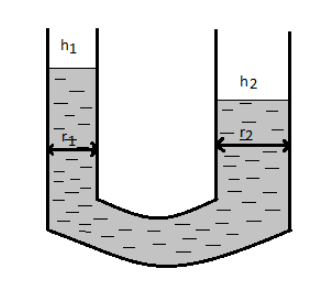
The radii of the two columns in a $U$ tube are ${r_1}$ and ${r_2}$, when a liquid of density (angle of contact is \[{0^o}\]) is filled in it, the level difference of the liquid in the two arms in $h$. The surface tension of the liquid is: ($g = $acceleration due to gravity).
(A) $\dfrac{{\rho gh{r_1}{r_2}}}{{2({r_2} - {r_1})}}$
(B) $\dfrac{{\rho gh({r_2} - {r_1})}}{{2{r_2}{r_1}}}$
(C) \[\dfrac{{2({r_1} - {r_2})}}{{\rho gh{r_2}{r_1}}}\]
(D) \[\dfrac{{2({r_1} - {r_2})}}{{\rho gh}}\]
Answer
564k+ views
Hint: Surface tension is nothing but the ability of liquid surfaces to shrink into minimum surface area. This property of a liquid allows it to block an external force as its molecules have cohesive nature.
Formula used:
The rise of liquid in the capillary tube can be calculated using the formula $h = \dfrac{{2T}}{{r\rho g}}$.
Complete step by step answer:
The cohesive nature of the liquid molecules is responsible for resisting an external force and shrinking into the minimum surface possible. This phenomenon is called as surface tension.

Let ${h_1}$ be the height in the tube having radius ${r_1}$.
So, we have ${h_1} = \dfrac{{2T}}{{{r_1}\rho g}} - - - - - (1)$
Similarly, let ${h_2}$ be the height in the tube having radius ${r_2}$.
So, we have ${h_2} = \dfrac{{2T}}{{{r_2}\rho g}} - - - - - (2)$
The level difference of liquid in the two arms can be given by
$h = {h_1} - {h_2}$
After substituting values from equations $(1)$ and $(2)$, we get
\[
h = \dfrac{{2T}}{{{r_1}\rho g}} - \dfrac{{2T}}{{{r_2}\rho g}} \\
\Rightarrow h = \dfrac{{2T}}{{\rho g}}[\dfrac{1}{{{r_1}}} - \dfrac{1}{{{r_2}}}] \\
\therefore h = \dfrac{{2T}}{{\rho g}}[\dfrac{{{r_2} - {r_1}}}{{{r_1}{r_2}}}] \\
\]
After rearranging the terms, we get $T = \dfrac{{h\rho g{r_1}{r_2}}}{{2({r_2} - {r_1})}}$
Thus, we can conclude that the surface tension of the liquid is $\dfrac{{\rho gh{r_1}{r_2}}}{{2({r_2} - {r_1})}}$.
So, option A is the correct answer.
Note: In this example, the height $h$ was mentioned, so we used the formula $h = \dfrac{{2T}}{{r\rho g}}$. For other examples, force and length can also be used to find out the surface tension by using the formula, $T = \dfrac{1}{2} \times \dfrac{F}{L}$where $T$ is the surface tension, $F$ is the force, and $L$ is the length.
Formula used:
The rise of liquid in the capillary tube can be calculated using the formula $h = \dfrac{{2T}}{{r\rho g}}$.
Complete step by step answer:
The cohesive nature of the liquid molecules is responsible for resisting an external force and shrinking into the minimum surface possible. This phenomenon is called as surface tension.

Let ${h_1}$ be the height in the tube having radius ${r_1}$.
So, we have ${h_1} = \dfrac{{2T}}{{{r_1}\rho g}} - - - - - (1)$
Similarly, let ${h_2}$ be the height in the tube having radius ${r_2}$.
So, we have ${h_2} = \dfrac{{2T}}{{{r_2}\rho g}} - - - - - (2)$
The level difference of liquid in the two arms can be given by
$h = {h_1} - {h_2}$
After substituting values from equations $(1)$ and $(2)$, we get
\[
h = \dfrac{{2T}}{{{r_1}\rho g}} - \dfrac{{2T}}{{{r_2}\rho g}} \\
\Rightarrow h = \dfrac{{2T}}{{\rho g}}[\dfrac{1}{{{r_1}}} - \dfrac{1}{{{r_2}}}] \\
\therefore h = \dfrac{{2T}}{{\rho g}}[\dfrac{{{r_2} - {r_1}}}{{{r_1}{r_2}}}] \\
\]
After rearranging the terms, we get $T = \dfrac{{h\rho g{r_1}{r_2}}}{{2({r_2} - {r_1})}}$
Thus, we can conclude that the surface tension of the liquid is $\dfrac{{\rho gh{r_1}{r_2}}}{{2({r_2} - {r_1})}}$.
So, option A is the correct answer.
Note: In this example, the height $h$ was mentioned, so we used the formula $h = \dfrac{{2T}}{{r\rho g}}$. For other examples, force and length can also be used to find out the surface tension by using the formula, $T = \dfrac{1}{2} \times \dfrac{F}{L}$where $T$ is the surface tension, $F$ is the force, and $L$ is the length.
Recently Updated Pages
Master Class 11 Economics: Engaging Questions & Answers for Success

Master Class 11 English: Engaging Questions & Answers for Success

Master Class 11 Social Science: Engaging Questions & Answers for Success

Master Class 11 Biology: Engaging Questions & Answers for Success

Class 11 Question and Answer - Your Ultimate Solutions Guide

Master Class 11 Business Studies: Engaging Questions & Answers for Success

Trending doubts
What is meant by exothermic and endothermic reactions class 11 chemistry CBSE

10 examples of friction in our daily life

One Metric ton is equal to kg A 10000 B 1000 C 100 class 11 physics CBSE

Difference Between Prokaryotic Cells and Eukaryotic Cells

What are Quantum numbers Explain the quantum number class 11 chemistry CBSE

1 Quintal is equal to a 110 kg b 10 kg c 100kg d 1000 class 11 physics CBSE




